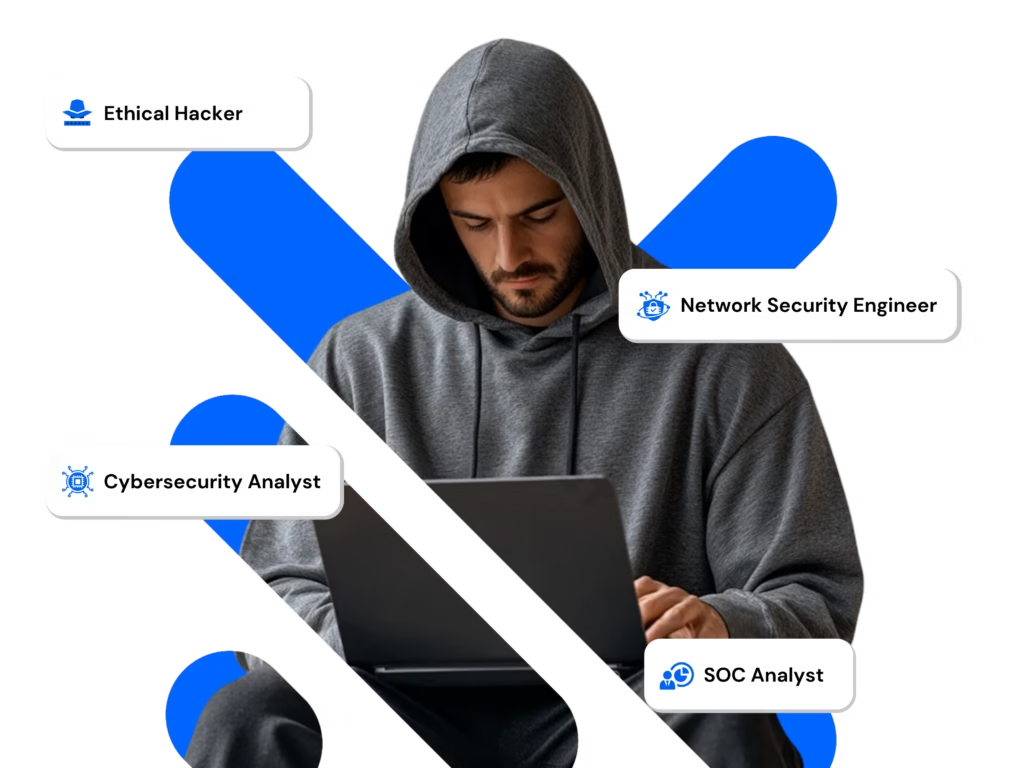Table of Contents

A widely recognized certificate for information security experts, the CISSP certification covers 8 major domains. These domains include Security and Risk Management, Asset Security, Security Architecture and Engineering, Communication and Network Security, Identity and Access Management, Security Assessment and Testing, Security Operations, and Software Development Security. Every domain covers important topics and useful abilities required to defend organizations from cyberspace assaults. Both experienced security professionals and those who are just beginning must have a solid understanding of these areas. This guides offers a clear, brief summary of each of the eight domains and an organized road map to assist learners in completing the CISSP certification process.
What is CISSP Certification?

The prestigious CISSP (Certified Information Systems Security Professional) certification, provided by (ISC)2, demonstrates proficiency in planning, executing, and overseeing cybersecurity programs. It demonstrates proficiency in several security domains and is acknowledged globally. For security managers, analysts, architects, and IT workers looking to progress in their professions, the certification is perfect. CISSP places a strong emphasis on risk management, strategic decision-making, and practical understanding. Understanding the eight domains, understanding regulatory frameworks, and accumulating practical experience are all necessary for CISSP preparation. Gaining CISSP sets people as leaders who can protect companies from advanced cyberthreats, improves professional chances, and communicates credibility to employers.Eight key domains are covered by the CISSP certification, which collectively offers a thorough framework for understanding information security.
CISSP Domain 1: Security and Risk Management
The goal of security and risk management is to safeguard corporate assets by developing, putting into practice, and upholding policies, processes, and frameworks. It involves staying aware of governance, risk analysis, legal requirements, and compliance. Professionals acquire the skills necessary to identify risks, control weaknesses, and create plans for business continuity. This area places a strong emphasis on strategic planning, security awareness, and moral behavior. Regulatory compliance and standards such as ISO 27001 and NIST must also be understood by candidates.
To reduce organizational risks and provide resilience against cyber threats, it is essential to have a solid understanding of security and risk management. All other CISSP domains are supported by this fundamental domain, which gives experts the tools they need to make wise security judgments.Professionals who possess a thorough understanding of security and risk management are able to make well-informed decisions that safeguard people and technology. Additionally, it establishes the framework for creating efficient rules in the other CISSP domains.
CISSP Domain 2: Asset Security
The goal of asset security is to safeguard organizational resources and important data at every stage of their existence. It involves organizing data, putting data handling protocols into practice, putting privacy regulations into place, and making sure that data is stored and disposed of securely. To protect sensitive data, professionals study encryption, data retention techniques, and access control mechanisms. The risk of data breaches, leaks, or unauthorized usage is decreased by effective asset management. It is crucial for understanding corporate policies, legal requirements, and intellectual property protection. Information assets are kept private, essential, and accessible through mastery of asset security. For CISSP candidates looking to acquire tangible and intangible organizational resources, this domain is important.
CISSP Domain 3: Security Architecture and Engineering
The field of security architecture and engineering deals with creating safe networks, applications, and systems. Secure frameworks, cryptography, vulnerability assessment, and defense-in-depth strategies are the primary areas of emphasis. Experts are trained to spot flaws, put security measures in place, and incorporate best practices into system architecture. Emerging technologies, cloud computing, and physical security are also covered in this domain. It is crucial for understanding encryption techniques, secure protocols, and architectural principles.Building resilient infrastructures that can withstand cyberattacks is made possible by mastery. CISSP candidates must ensure that systems are secure throughout their lifecycle by applying engineering concepts in conjunction with security criteria. In this field, theory and real-world application are connected to provide strong organizational protection.
CISSP Domain 4: Communication and Network Security
The goal of communication and network security is to safeguard data, protocols, and networks while they are in transit. It involves developing secure network designs, putting intrusion detection systems, firewalls, and VPNs into installation, and making sure that confidentiality and integrity are maintained. Professionals are trained in wireless network security, secure communication methods, and threat mitigation. It is essential for understanding risk management, segmentation, and network protocols. By understanding this domain, CISSP candidates can maintain secure information flows, stop unwanted access, and protect against cyberattacks that target communication channels.A critical ability for all cybersecurity workers, strong networking knowledge in combination with security experience guarantees that businesses stay strong against internal and external attacks.
CISSP Domain 5: Identity and Access Management (IAM)
IAM is mainly concerned with regulating access to organizational resources and managing digital identities. Privilege management, multifactor authentication, single sign-on, authorization, and authentication are all covered in this domain. Professionals are trained to put policies in place that guarantee sensitive data is only accessed by authorized individuals. IAM improves compliance, safeguards information assets, and lessens insider threats. It is necessary to understand account provisioning, identification frameworks, and access evaluation procedures. By preventing security breaches, mastery of IAM guarantees that users have the appropriate rights at the appropriate times. Being proficient in IAM allows CISSP candidates to effectively restrict organizational access, protecting systems and data from compromise or illegal usage.
CISSP Domain 6: Security Assessment and Testing
Professionals can learn how to evaluate systems, networks, and policies for vulnerabilities and compliance through security assessment and testing. Risk analysis, vulnerability scanning, security audits, and penetration testing are all included. Candidates gain experience in creating, carrying out, and reporting evaluation processes while making sure that corporate goals are fulfilled. Frequent testing increases defenses, minimizes attack surfaces, and finds vulnerabilities. It’s critical to understand reporting guidelines, security measures, and mitigating techniques. Gaining proficiency in this area gives CISSP candidates the useful abilities to evaluate security posture, rank hazards, and suggest enhancements, guaranteeing that businesses stay safe and compliant from online attacks.
CISSP Domain 7: Security Operations
Through security assessment and testing, professionals can learn how to review networks, policies, and systems for vulnerabilities and compliance. Included are penetration testing, security audits, risk assessments, and vulnerability scanning. As they ensure that company objectives are met, candidates acquire experience in developing, implementing, and reporting evaluation procedures. Regular testing identifies weaknesses, reduces attack surfaces, and strengthens defenses. Understanding reporting policies, security precautions, and mitigating strategies is essential. Acquiring expertise in this field equips CISSP candidates with practical skills to assess security posture, prioritize risks, and recommend improvements, ensuring that companies remain secure and compliant against cyberattacks.
CISSP Domain 8: Software Development Security
Integrating security across the software development lifecycle (SDLC) is the main goal of software development security. Code review, application testing, vulnerability management, and secure coding are all covered. Experts acquire the skills necessary to spot typical coding errors, use safe design concepts, and stop vulnerabilities. It is crucial to understand secure deployment, risk assessment, and development frameworks. Application resilience is ensured by mastery, which reduces an organization’s exposure to cyberthreats. A key competency for safeguarding contemporary IT environments is the ability of CISSP candidates with software security expertise to work with developers, apply secure coding standards, and make sure apps fit with organizational security policies.
Tips for Studying all 8 Domains
Each of the eight vital domains that make up the CISSP certification focuses on an individual aspect of information security. Structured study, real-world experience, and regular revision in all areas are necessary for effective preparation. Concentrate on understanding ideas, learning important vocabulary, and applying real-world situations to every subject. To pinpoint areas of weakness and strengthen learning, use practice tests. For deeper insights, study current security trends and participate in discussion groups. To assist students in effectively grasping all eight CISSP domains, SenseLearner Academy provides carefully chosen courses and professional advice. Exam preparation is ensured by creating a daily study schedule and monitoring results.
Conclusion
A globally renowned certificate, the CISSP certification attests to proficiency in eight essential information security fields. Together, the fundamental ideas, abilities, and best practices covered in each domain enable professionals to protect corporate assets from constantly changing cyberthreats. Success is mostly dependent on methodical research, practical experience, and strategic planning. Aspiring cybersecurity professionals can confidently earn CISSP certification, expand their knowledge, and further their careers in the quickly changing world of cybersecurity by adhering to a structured study schedule and utilizing top-notch resources.
FAQ’s
What advantages come with becoming certified as a CISSP?
The CISSP certification expands job options worldwide, shows proficiency in a variety of cybersecurity fields, and improves professional reputation. Professionals are qualified for high-level positions like IT director, security manager, or security consultant. In order to create strong security programs, CISSP holders get a greater understanding of risk management, governance, and compliance. Employers view CISSP as a standard of theoretical and practical competence, which frequently results in increased pay and possibilities for leadership. Furthermore, while obtaining Continuing Professional Education (CPE) credits is necessary to maintain the credential, it encourages lifelong learning by keeping professionals abreast of new risks and changing security procedures.
How frequently does the CISSP certification need to be renewed?
The CISSP certification is good for three years. Holders must earn 120 Continuing Professional Education (CPE) credits throughout the course of the three-year cycle in order to keep it. This guarantees that experts stay up-to-date with changing cybersecurity laws, trends, and technologies. Professional development classes, webinars, seminars, article writing, and industry gatherings are examples of CPE activities. There is also an annual maintenance fee associated with renewal. Maintaining compliance upholds the CISSP certification’s validity and worth in the cybersecurity community, guarantees understanding of new risks and best practices, and shows a continuous dedication to professional development.
Can CISSP help in higher earnings and professional growth?
The internationally recognized CISSP degree greatly improves earning potential and job possibilities. It makes workers eligible for high-level positions like director, consultant, security manager, or CISO. Professionals with CISSP certification are valued by employers for their strategic knowledge of governance, risk management, and security. Industry polls indicate that CISSP holders frequently make more money than their non-certified peers. Beyond financial gains, CISSP provides access to leadership roles, international mobility, and respect as a cybersecurity authority. Additionally, it exhibits a continuous dedication to professional growth, which is highly regarded in dynamic security contexts.





